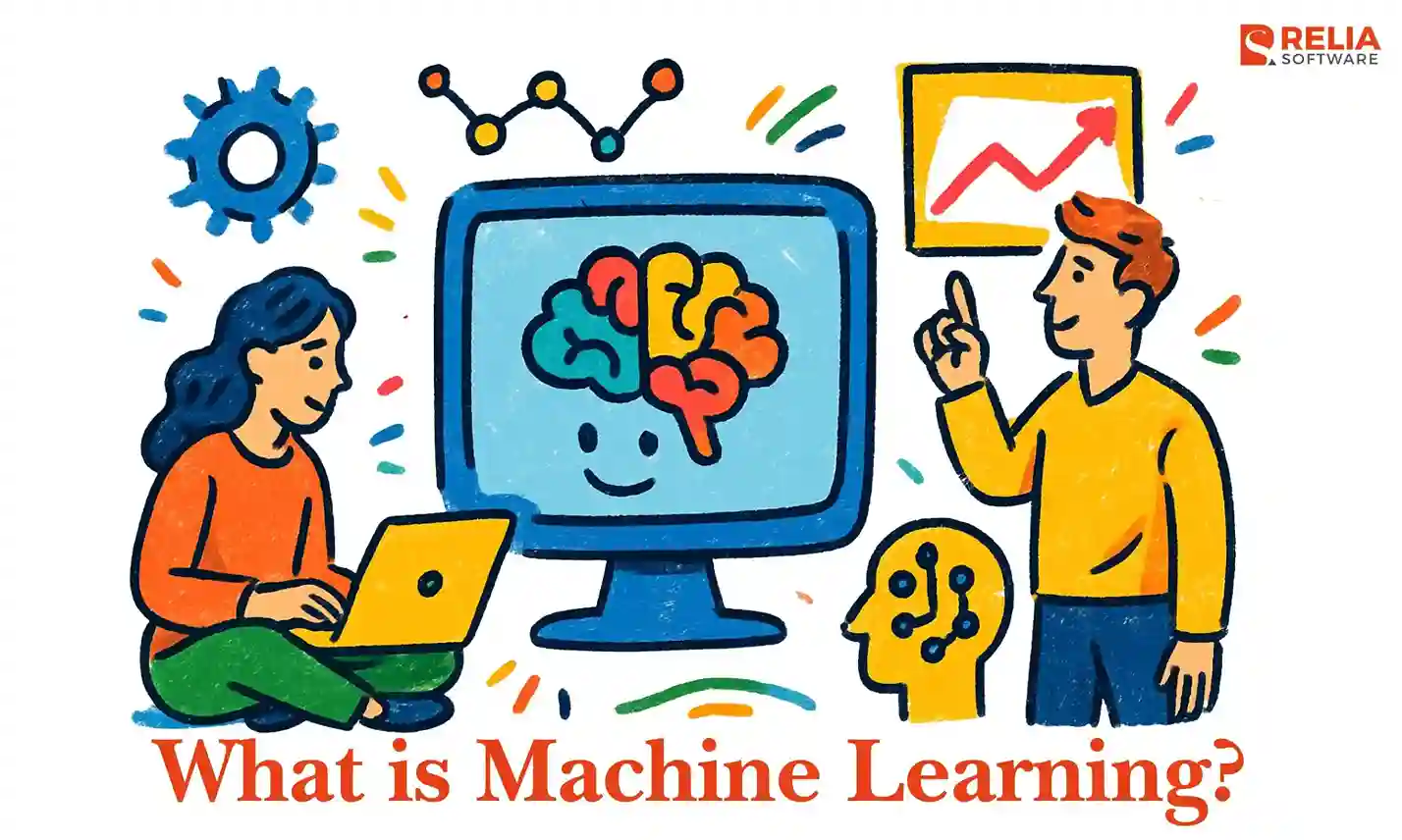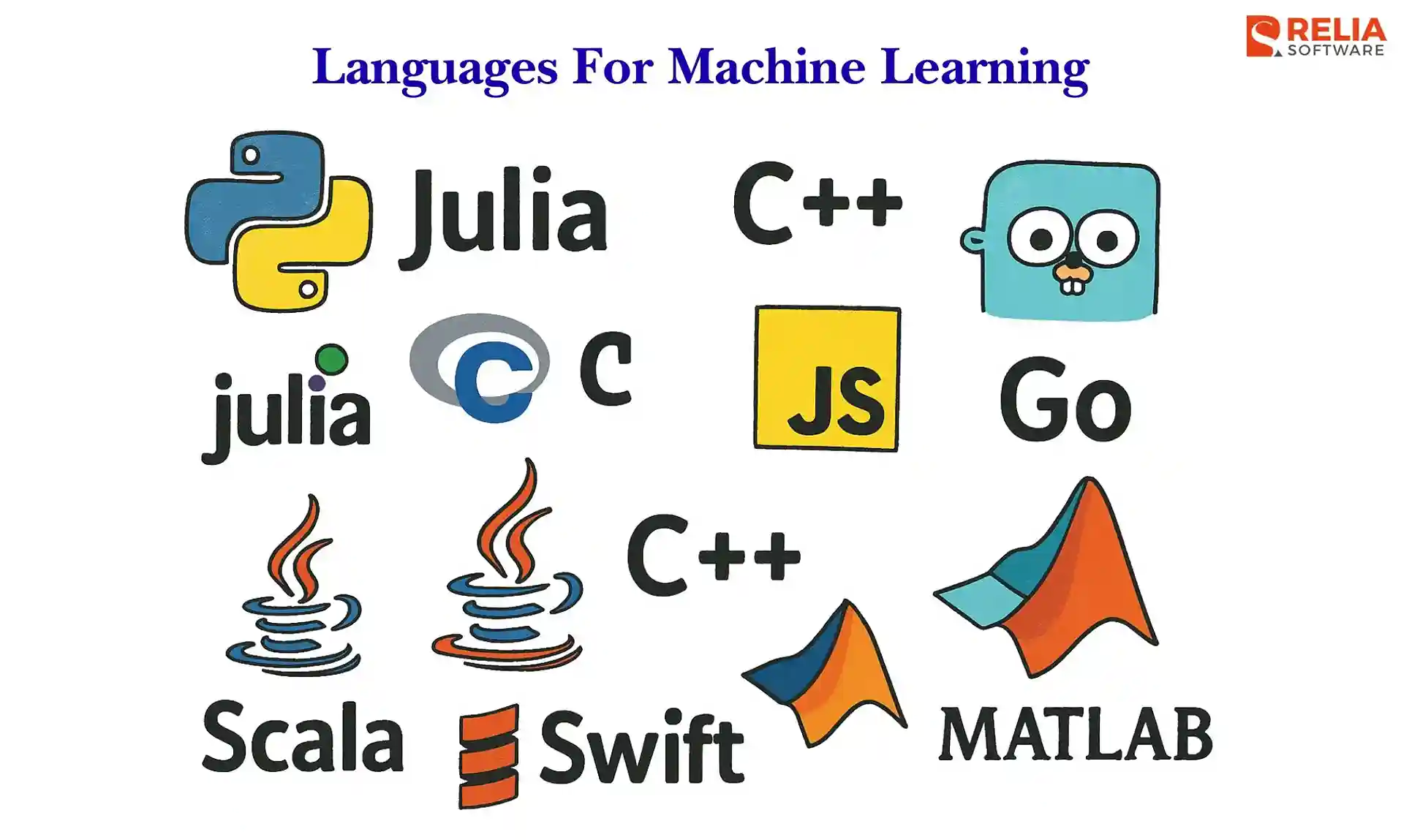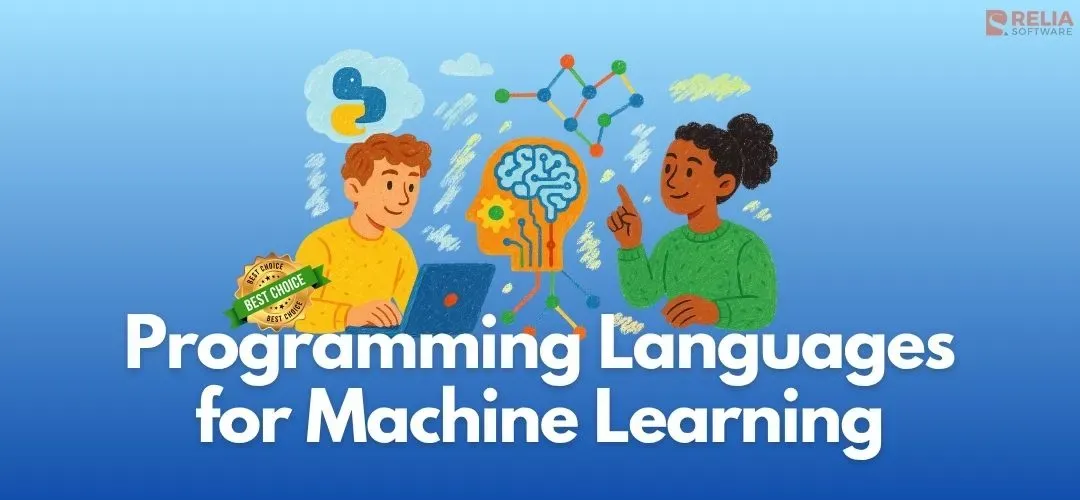Machine learning is one of the fastest-growing fields in tech, powering everything from personalized recommendations to self-driving cars. As demand for AI continues to rise, so does the need for developers who can build smart, data-driven systems. According to the U.S. Bureau of Labor Statistics report, the demand for machine learning engineers is expected to grow by 22% between 2022 and 2030.
However, no single programming language is perfect for every task. Different languages shine in different areas, so the "best" language depends on your goals and needs. So, which programming languages should you learn?
Below, we provide an overview of several popular programming languages for machine learning, explaining their strengths, typical use cases, and where they fit in the ML landscape.
What is Machine Learning?
Machine Learning (ML) is a field of computer science that teaches computers to learn from data and make decisions without being explicitly programmed. In simple terms, instead of writing step-by-step instructions, you'll need to give the computer lots of examples, and it learns patterns to make predictions or take actions on its own.
This technology is the one behind things like movie recommendations, voice assistants, and spam filters that you may have recently seen on a lot of applications, helping systems get smarter the more they learn.
Some common use cases for machine learning are:
- Spam detection: Filtering unwanted emails automatically.
- Product recommendations: Suggesting items based on what you’ve viewed or bought.
- Voice recognition: Powering assistants like Siri, Alexa, or Google Assistant.
- Image classification: Identifying objects or people in photos.
- Fraud detection: Spotting suspicious activity in banking or e-commerce.
- Self-driving cars: Helping vehicles recognize traffic signs, pedestrians, and road conditions.
- Chatbots: Responding to customer questions in real time.
>> Read more:
- Top 7 Machine Learning Solutions For Growing Your Business
- Top 9 Best Chatbot Development Frameworks
- Top 12 Best Free AI Chatbots for Businesses

Best Languages For Machine Learning
Before going into detail, let’s have a look at this table overview.
Language | Library Support | Best for | Example Use-cases |
Python | Scikit-learn, TensorFlow, PyTorch | Beginners, data science students | Building AI chatbots with NLP |
R | ggplot2, caret, randomForest | Statistical researchers, data analysts | Running time-series forecasting |
Julia | Flux.jl, MLJ.jl | Scientific computing, high-performance ML | Simulating climate or physics models |
Java | Weka, Deeplearning4j, Spark MLlib | Enterprise applications | Credit scoring in banking systems |
Scala | Apache Spark MLlib | Big data and distributed ML systems | Large-scale customer churn prediction |
C++ | Caffe, Dlib, TensorRT | Low-level ML, embedded systems | Real-time object detection in robotics |
JavaScript | TensorFlow.js, Brain.js | Web developers, browser-based inference | Gesture recognition in browser games |
Go | Gorgonia, Goml | Backend ML services, real-time systems | Live product recommendations via API |
MATLAB | Statistics and Machine Learning Toolbox | Engineering, academic prototyping | Designing control systems in aerospace |
Swift | Core ML | iOS developers, mobile ML deployment | Offline text classification in iOS apps |
Python
Python is the most used language in machine learning thanks to its clean syntax and powerful libraries. It’s great for building models quickly, experimenting with data, and running end-to-end ML pipelines. You can even speed up performance by using tools like Numba or combining Python with C++ for heavy tasks.
Python tools make everything from data prep to deep learning simpler and more efficient with AI-powered apps, even though Python isn’t the fastest language. Its huge community and strong support also make it easy to learn, troubleshoot, and build real-world ML projects quickly.
Ecosystem: TensorFlow, PyTorch, Scikit-learn, Jupyter
Applications:
- Natural language processing (chatbots, sentiment analysis)
- Image classification and object detection
- Fraud detection and predictive analytics
- Recommender systems (e.g., Netflix, Amazon)
- Time-series forecasting
R
R is a favorite in academic and research settings, which is built for statistics, modeling, and data visualization to explain your results clearly. This language is the favorite language of statisticians and data scientists, especially for analyzing data and testing ideas. R makes it easy to run machine learning experiments and share results with clear charts and summaries.
However, R is not the top choice for large-scale machine learning or production systems due to its limitations in general-purpose programming. Many developers build models in R for analysis, but later move them to Python or Java when it’s time to deploy.
Ecosystem: ggplot2, caret, randomForest
Applications:
- Statistical modeling and hypothesis testing
- Predictive modeling for marketing and healthcare
- Data visualization for research reports
- Bioinformatics and genomic analysis
- Financial time-series modeling
Julia
Julia is an “aspiring” top-tier ML language that many consider the future for scientific machine learning workloads. This newer language combines high performance with simple code. It is like Python to write, but performs more like C in many cases.
In terms of application, Julia is great for complex mathematical models and large-scale numerical computing. It’s often used in scientific research and is becoming more common in machine learning projects that need speed and accuracy.
Ecosystem: Flux.jl, MLJ.jl, Knet.jl
Applications:
- Scientific simulations (e.g., climate, physics, energy systems)
- High-speed numerical analysis
- Deep learning in research environments
- Optimization-heavy ML tasks
- Real-time algorithmic trading models
Java
Java is widely used in machine learning, especially in enterprise applications like web services or big data pipelines in banks or retail. It runs fast, handles heavy workloads, and its strong structure makes it easier to manage big projects. Many teams build models in Python, then use Java to turn them into stable, scalable applications.
Moreover, Java is also great for putting machine learning into action. It's often used to embed models into scalable server apps or Android apps. Many financial and enterprise systems rely on Java for ML tasks like fraud detection, recommendations, and other features used in real-world products.
Ecosystem: JVM, Spark MLlib, Weka
Applications:
- Credit scoring and risk modeling in banking
- Large-scale recommendation systems
- Fraud detection in fintech apps
- Real-time ML in telecom and IoT application
- ML-powered search and indexing
Scala
Scala runs on the Java platform but offers a more modern, expressive way to write code. This language combines functional and object-oriented programming, which some developers find more flexible.
It works well with Apache Spark, one of the most popular big data tools used in machine learning. Moreover, with Spark MLlib, you can also train models across massive datasets quickly. In simpler terms, Scala is great when you need to run ML on big data, for example, building a recommendation system or classification model that crunches through logs or user data spread across a cluster.
Ecosystem: Apache Spark MLlib
Applications:
- Real-time clickstream analysis
- Personalization in e-commerce platforms
- Social media sentiment tracking
- Predictive maintenance in manufacturing
C++
C++ is not a typical first choice for building ML models, but it plays a key role when speed and performance really matter. C++ gives you full control over memory and execution, which is essential for building high-performance ML engines. This language is often used behind the scenes in machine learning tools, especially where performance really matters, like in AI games, robotics, or edge devices.
While it's harder to learn and slower to develop than Python, it’s ideal for running ML on devices with limited resources, like in mobile apps, IoT, or even self-driving cars. Frameworks like Caffe and TensorRT also use C++ for deep learning tasks that need fast, efficient code.
Performance: Maximum control and speed
Applications:
- Embedded AI for robotics and drones
- Real-time object tracking in surveillance systems
- Edge AI in autonomous vehicles
- Facial recognition in security devices
- High-performance inference engines
>> Read more: Top 8 Best Free C++ IDEs Developers Should Know
JavaScript
JavaScript isn’t a typical machine learning language, but it brings machine learning to the browser. With tools like TensorFlow.js and Brain.js, developers can train and run ML models using only JavaScript, no server needed. This makes it great for interactive web apps where users can try ML features directly on the page. While JavaScript is not commonly used for heavy-duty model training, it’s better for visualizing or running simple models in the browser.
Ecosystem: TensorFlow.js, Brain.js
Applications:
- In-browser face detection (e.g., webcam apps)
- Real-time gesture recognition in games
- Spam detection in contact forms
- Client-side recommendation widgets
- On-page handwriting or drawing recognition
>> Read more:
- What Can You Do With JavaScript? 8 Popular JavaScript Usages
- A Comprehensive Guide of SOLID Principles in JavaScript
- Top 12 Best Javascript Frameworks for Your Projects
Golang
Golang (or Go) is a simple, fast language developed by Google. Although it isn’t widely used for building machine learning models themselves, it’s becoming a solid choice for the systems around ML, like data pipelines, APIs, and real-time analytics. Its fast runtime, simple syntax, and built-in support for concurrency make it great for performance-heavy tasks.
Libraries like Gorgonia and Goml bring machine learning functionality to Go, and it's also gaining popularity for backend AI tasks. Many teams also use Go to handle streaming data or serve ML models efficiently in production, especially when speed and scalability are key.
Ecosystem: Gorgonia, Goml
Applications:
- Real-time product recommendations via APIs
- ML-powered log analysis and anomaly detection
- Predictive alerts in monitoring systems
- ML as a microservice in cloud-native apps
- Lightweight image or text classification services
>> Read more: 14 Golang Project Ideas For All Skill Levels Of Developers
MATLAB
MATLAB is widely used in engineering and research, also trusted in fields like aerospace, biomedical, and control systems. It was one of the first tools used for matrix math, signal processing, and algorithm testing, which naturally became part of early machine learning work too.
This language is especially helpful for math-heavy tasks like signal processing, control systems, or simulations. MATLAB has built-in tools for machine learning and deep learning, so you don’t need to install much to get started. It’s not open-source, which can be a drawback, but its ease of use makes it popular in academic and scientific communities.
Use Case: Prototyping algorithms in research and engineering
Applications:
- Control system design in engineering
- Signal processing with ML support
- Fault detection in industrial machines
- Sensor data modeling in automotive research
- Predictive algorithms for academic experiments
Swift
Swift is a programming language used for building iOS apps. This language isn’t typically used to build machine learning models, but it plays a key role in running them on Apple devices. With Apple’s Core ML framework, developers can run ML directly on an iPhone or iPad, even without an internet connection. This is perfect for tasks like image recognition, personalization, or AR features. Swift is the best choice for developers building smart, ML-powered apps on Apple platforms.
Ecosystem: Core ML
Applications:
- Offline image recognition in iOS apps
- Voice command features in smart apps
- On-device text classification (e.g., spam filter)
- Health and fitness app predictions
- Smart camera or AR features using Core ML
>> Read more: Swift vs Objective-C: Which One Is Better For iOS Development?

How to Choose the Right Language for Machine Learning?
- Ecosystem & Libraries: Choose a language with strong ML frameworks so you can build models faster and easier (e.g., Python with TensorFlow, PyTorch).
- Performance: Pick a high-speed language if your project needs fast execution or handles large data (e.g., C++, Julia, Go).
- Learning Curve & Syntax: Use beginner-friendly languages like Python to avoid complexity and focus on learning ML itself.
- Community & Documentation: A bigger community means more support, tutorials, and better documentation to help you solve problems faster.
- Domain Applicability: Match the language to your use case—Python for general ML, R for research, C++ for edge devices, Java for enterprise systems.
- Best Starting Point: Start with Python if you're unsure—it’s easy to learn and works well across most ML tasks.
FAQs
1. Is learning only Python enough for a machine learning career?
While Python is the main language in the field, knowing only Python might limit your flexibility. Depending on the role, you may also need SQL for data handling, R for statistics, or C++ for performance optimization. Python is only enough to get started and build a strong foundation.
2. Which language is best for deep learning?
Python is the most widely used language for deep learning. It supports top frameworks like TensorFlow, PyTorch, and Keras, and is compatible with GPU acceleration, making it ideal for training and deploying deep learning models.
3. Is JavaScript good for machine learning?
JavaScript isn’t ideal for training models, but it works well for deploying lightweight models in web apps using libraries like TensorFlow.js. It's useful for frontend ML applications and browser-based inference.
4. Can I switch languages in machine learning projects?
Yes. Many real-world ML systems are multilingual. You might prototype in Python, optimize components in C++, and deploy using Java or Go. Some tools even support language interoperability.
5. What language is used the most in machine learning jobs?
Python leads by a wide margin. It’s the top choice in most job listings due to its vast ecosystem, simplicity, and support for major ML frameworks.
>> Read more: 10+ Cloud Computing Programming Languages for Developers
Conclusion
At the end, there’s no “best” programming language for machine learning—only the best one for your goals and your use case. While Python is the most popular and beginner-friendly option, other languages like R, Julia, Scala, or C++ offer specific advantages depending on the task, industry, or system requirements.
Before choosing, think about what you're building, where it will run, and how much performance, scalability, or simplicity you need. Each language in this list brings something different to the table.
>>> Follow and Contact Relia Software for more information!
- development

